Understanding Pay Bands and How to Create Them
Learn how to create and implement pay bands, ensure fair compensation, and boost employee motivation with our step-by-step guide on performance pay management.
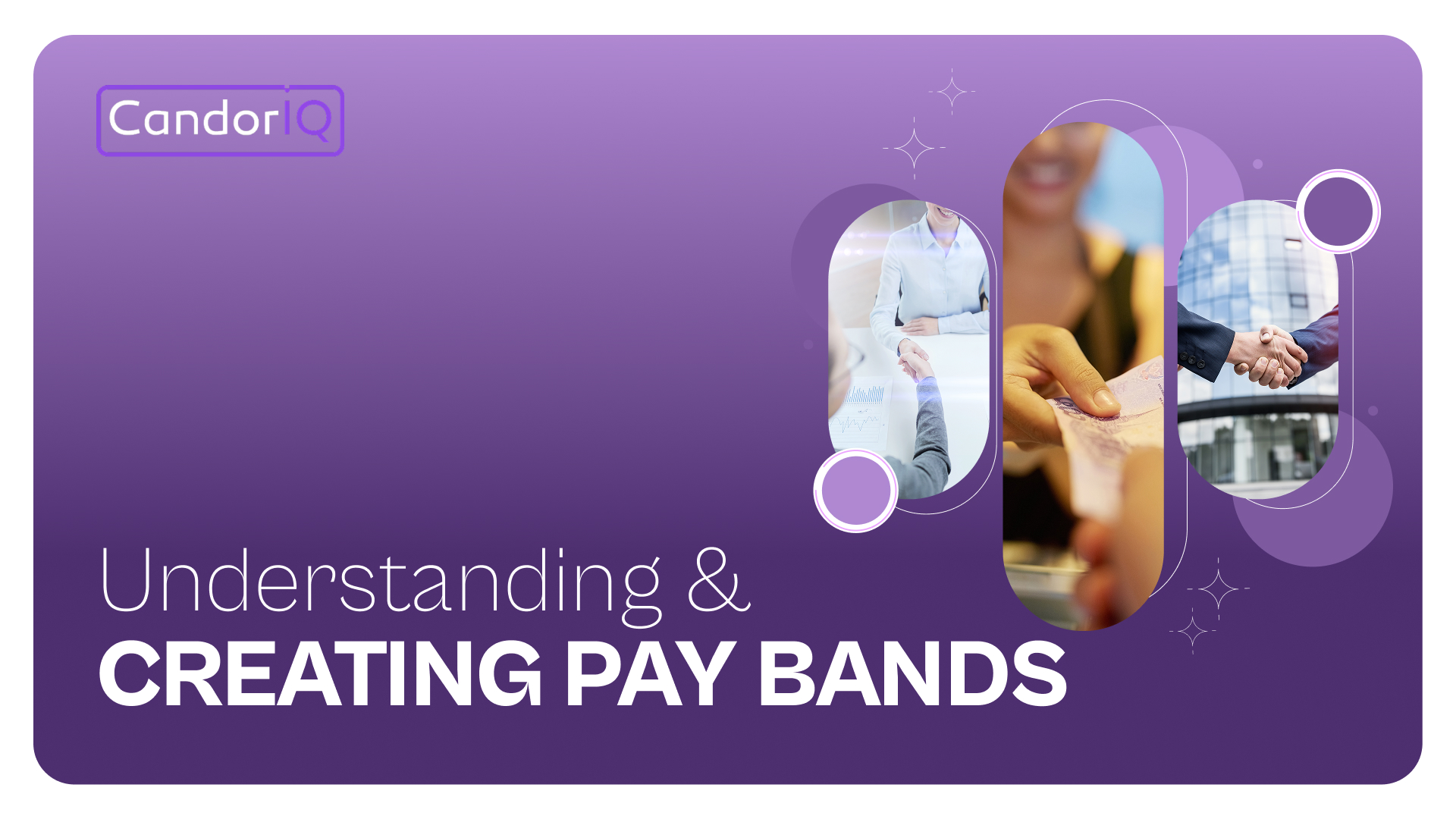
As an HR or finance leader, one of the most pressing challenges is ensuring fair and competitive pay across a growing workforce. With more employees and expanding teams, it becomes increasingly difficult to manage salary structures that are both equitable and aligned with the organization’s budget and goals.
The good news is that pay bands offer a clear solution. Today, we’ll see how pay bands can solve these challenges, align your compensation processes, and provide the clarity you need to make smarter decisions for your organization’s workforce.
TL;DR
- What Are Pay Bands? – A pay band is a salary range set for a specific role or level, outlining the minimum and maximum compensation within that range.
- How Pay Bands Work – Pay bands group similar roles and jobs together, allowing flexibility for pay progression based on experience, skills, and performance.
- Pay Bands vs. Pay Scales – While pay scales offer rigid salary ranges, pay bands provide broader, flexible ranges, supporting career progression and internal equity.
- The Benefits of Pay Bands – Pay bands ensure pay equity, improve talent attraction, support employee retention, and provide clear guidelines for salary increases.
- How to Create Pay Bands – A step-by-step guide for creating effective pay bands, from job role evaluation to market research and salary band implementation.
What Are Pay Bands?
A pay band is a salary range that defines the minimum and maximum compensation for a specific role or level within an organization. It provides a structured framework for setting salaries across similar roles, ensuring that pay remains consistent and fair.
Sometimes referred to as salary bands, compensation bands, or pay ranges, pay bands help organizations manage compensation with clarity, promoting both equity and transparency.
How Do Pay Bands Work?
Pay bands group similar roles into defined salary ranges based on factors like job responsibilities, experience, and skills. These ranges provide a framework for determining compensation across different levels, ensuring that salaries remain competitive and fair within the organization.
Pay bands are set by evaluating both internal and external factors that influence compensation.
- Market trends and industry standards play a key role in setting salary ranges to ensure competitiveness within the field.
- Internal policies and company budgets are also considered to ensure alignment with financial goals and organizational needs.
Now, let’s understand how pay bands differ from pay scales to determine which structure fits your organization best.
Pay Bands vs. Pay Scales: Understanding the Difference
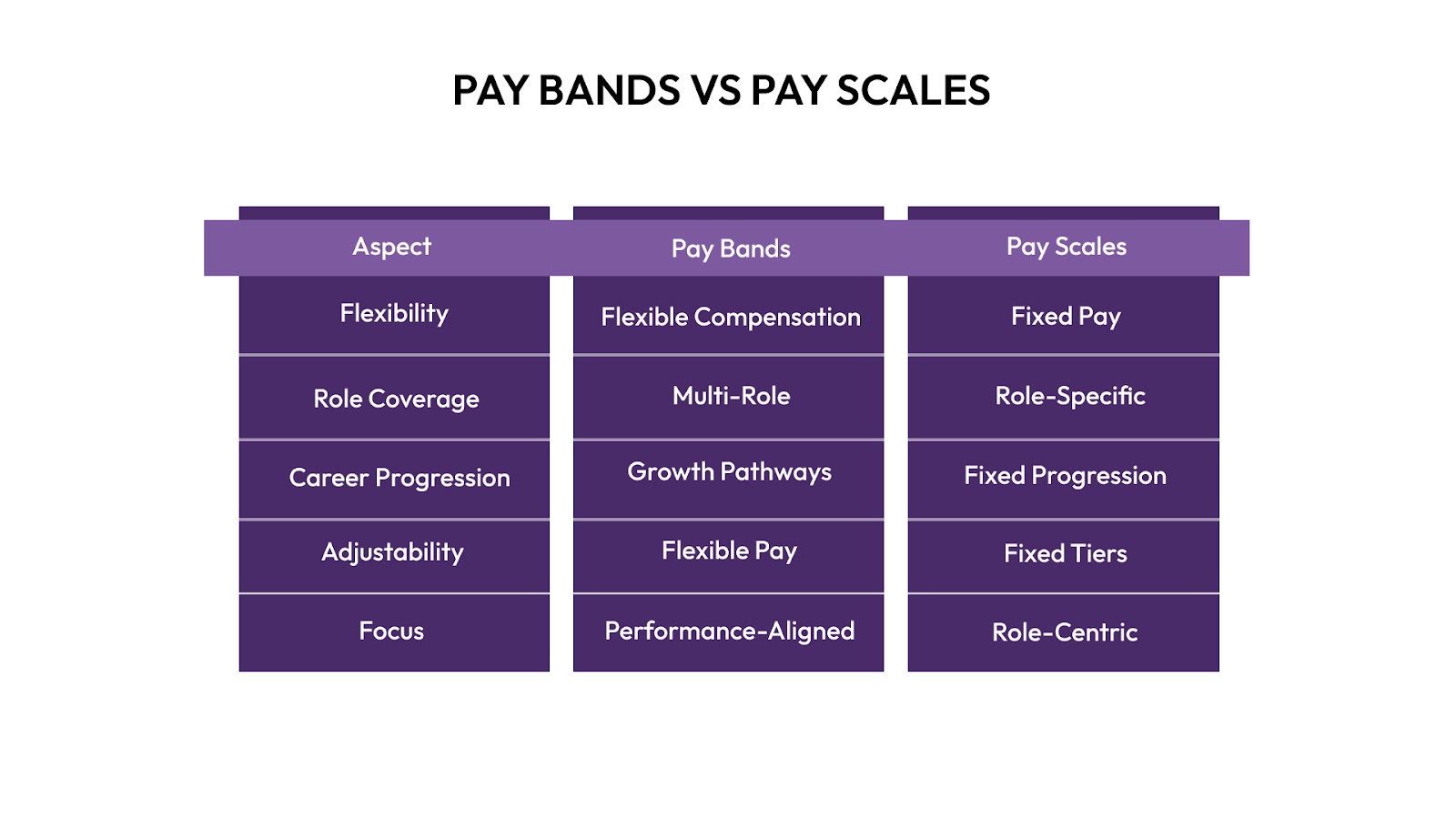
While pay bands and pay scales may seem similar, they serve different purposes and offer distinct advantages for compensation management.
Let’s explore how they compare:
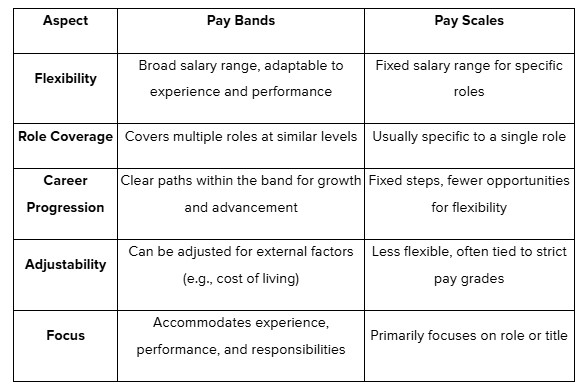
Pay bands provide organizations with the flexibility they need to reward employees based on their unique contributions, whereas pay scales often limit this flexibility.
Let’s discuss how pay bands benefit both employers and employees, driving greater satisfaction and alignment with company goals.
The Benefits of Pay Bands for Employers and Employees
Pay bands offer numerous advantages for both employers and employees, creating a more structured, transparent, and efficient compensation process. Let’s take a closer look at the specific benefits for each group.
Benefits for Employers
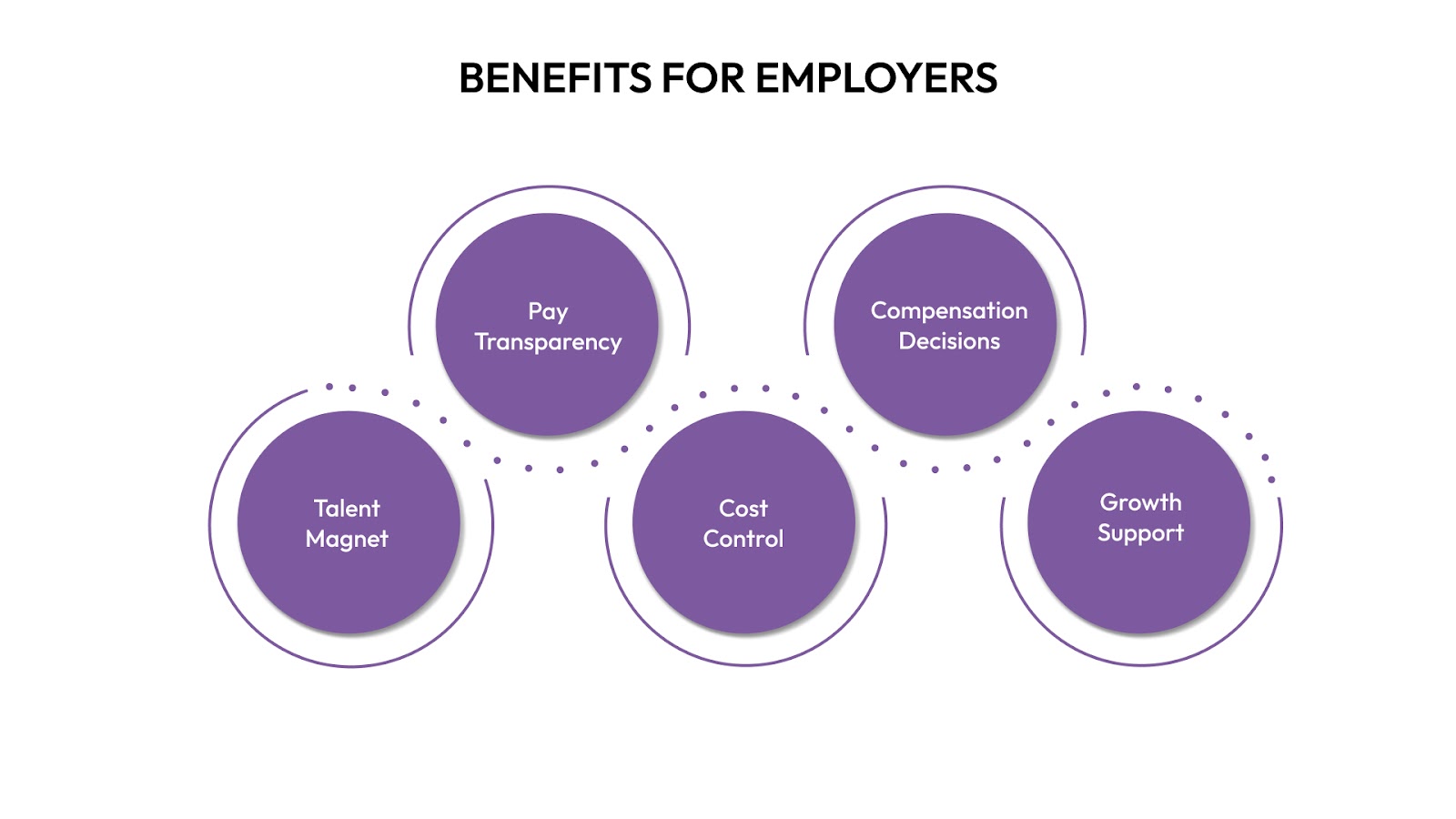
Pay bands help organizations streamline their compensation practices while ensuring fairness and consistency.
- Attracts and Retains Top Talent: Competitive pay bands make it easier to attract skilled candidates and retain valuable employees by providing clear salary expectations.
- Pay Transparency: Pay bands reduce internal pay disparities and foster trust by making compensation structures more transparent.
- Cost Control: Having clear salary ranges helps employers manage labor costs more effectively and stay within budgetary limits.
- Simplifies Compensation Decisions: Predefined pay bands streamline salary negotiations and eliminate confusion, leading to more efficient hiring.
- Supports Career Development: Pay bands give employees clear expectations for salary growth, improving motivation and engagement.
Benefits for Employees

For employees, pay bands offer clarity, fairness, and opportunities for growth within the organization.
- Clear Career Progression: Pay bands provide employees with a visible path for career advancement, motivating long-term personal and professional growth.
- Fair Compensation: Employees are paid according to their role and performance, reducing discrepancies and ensuring pay equity.
- Increased Job Satisfaction: Transparency and well-defined compensation structures help boost morale and engagement.
- Reduced Unconscious Bias: By focusing on role-related factors rather than personal characteristics, pay bands help mitigate discrimination.
- Improved Retention: With clear growth opportunities and fair compensation, employees are more likely to stay committed to the organization.
With a clear understanding of the benefits, let’s learn the steps to effectively create and implement a pay band for your organization.
How to Create Pay Bands?
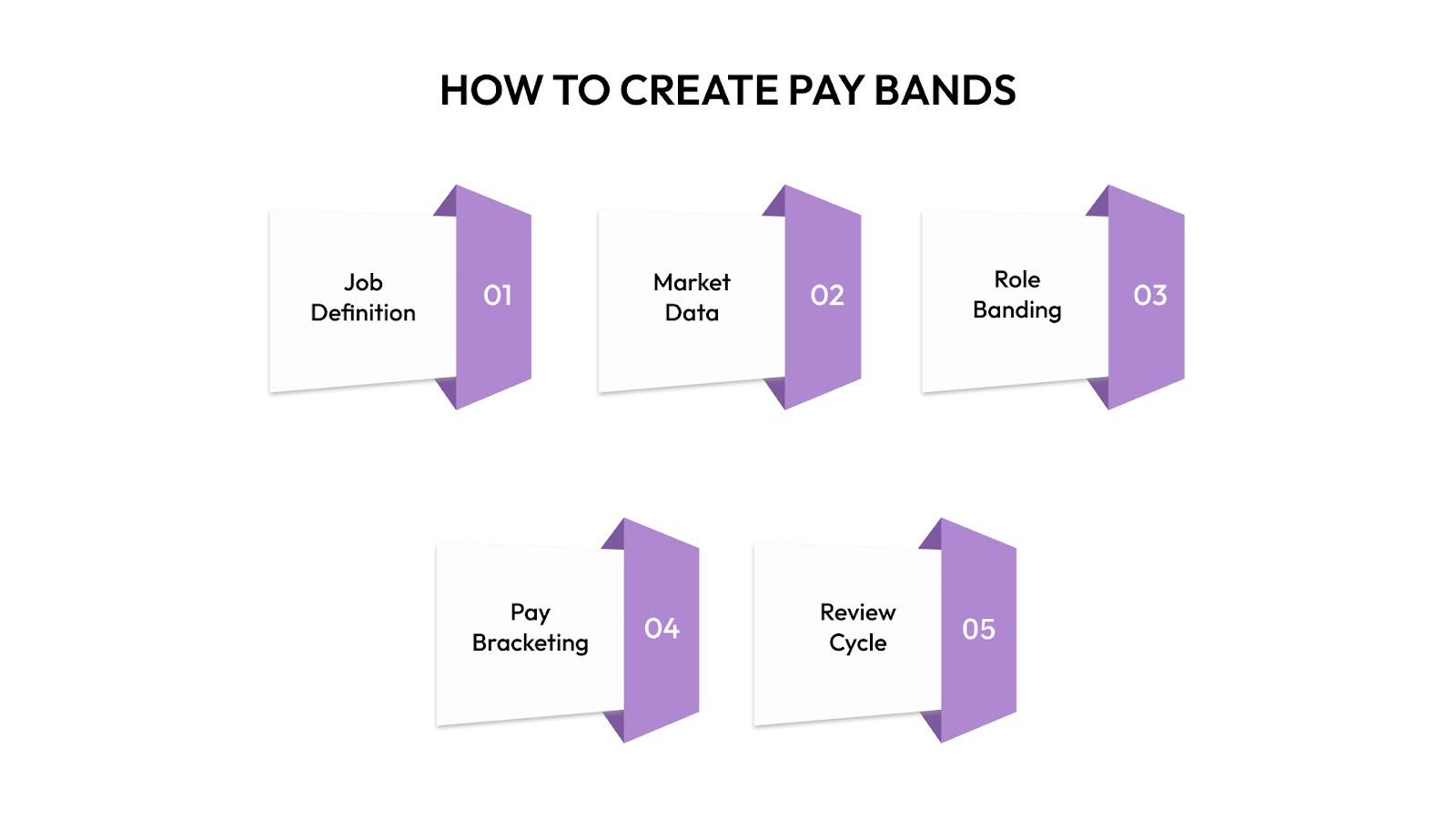
Creating effective pay bands is essential for ensuring fair compensation and managing salary structures efficiently. Here’s a simple, step-by-step process to help you build your pay bands.
Step 1: Define Job Roles and Responsibilities
The first step in creating pay bands is to define the job roles within your organization clearly. Make sure each role has a detailed job description outlining the key responsibilities, required skills, and experience needed. This will serve as the foundation for determining where each role fits within your pay bands.
Step 2: Evaluate Market Data
Research industry salary data and market trends to ensure your salary ranges remain competitive. Use reliable sources, such as salary surveys and government reports, to understand what similar roles in your industry and region are currently paying.
Step 3: Group Roles into Bands
Once you’ve defined the roles and collected market data, the next step is to group similar roles into pay bands. Assign roles to bands based on their level of responsibility, the experience required, and the skills needed for each position.
Step 4: Set Minimum, Midpoint, and Maximum Ranges
Determine the salary range for each band, including a minimum, midpoint, and maximum. Use the market data and your internal budget to set these ranges, ensuring that the salaries remain competitive but also align with your organization's financial goals.
Step 5: Regular Reviews and Adjustments
Pay bands should not be static. It’s important to regularly monitor market trends and adjust your salary ranges accordingly. Regular reviews ensure that your pay bands remain competitive and relevant as your business and the market evolves.
Now, to see how these pay bands come to life, let's see some examples.
Examples of Pay Bands in Action
Here are some hypothetical examples that show how pay bands apply to different roles across various levels in an organization.
Example 1: Junior Software Engineer
A junior software engineer is typically placed in Pay Band 1, where the salary range is determined by their experience and skill set.
- Salary Range: $60,000–$80,000
- Growth Potential: As the engineer gains more experience and takes on more complex tasks, their salary increases within the band. They may eventually move to Pay Band 2 (mid-level), with a higher salary range.
Example 2: Senior Marketing Manager
A senior marketing manager generally falls within Pay Band 3, where the salary range reflects their years of experience, performance, and job responsibilities.
- Salary Range: $90,000–$120,000
- Growth Potential: With strong performance or increased responsibilities, they may advance to Pay Band 4, an executive level, with a broader salary range.
Example 3: Executive Assistant
An executive assistant in a large corporation may be placed in Pay Band 2, which reflects the level of responsibility and the scope of their role.
- Salary Range: $50,000–$70,000
- Growth Potential: As they gain experience or take on more complex administrative tasks, they can progress within the band or move into a higher band with more responsibility.
After seeing how pay bands can work for different roles, you may wonder how to put this into action.
In the next section, we’ll see how CandorIQ can make managing pay bands simpler, faster, and more effective for your organization.
How CandorIQ Helps with Pay Bands
If you're looking to streamline the management of pay bands, CandorIQ offers a range of tools to help you define, track, and adjust pay bands in alignment with market trends and your organization’s needs.
1. Compensation & Payband Builder
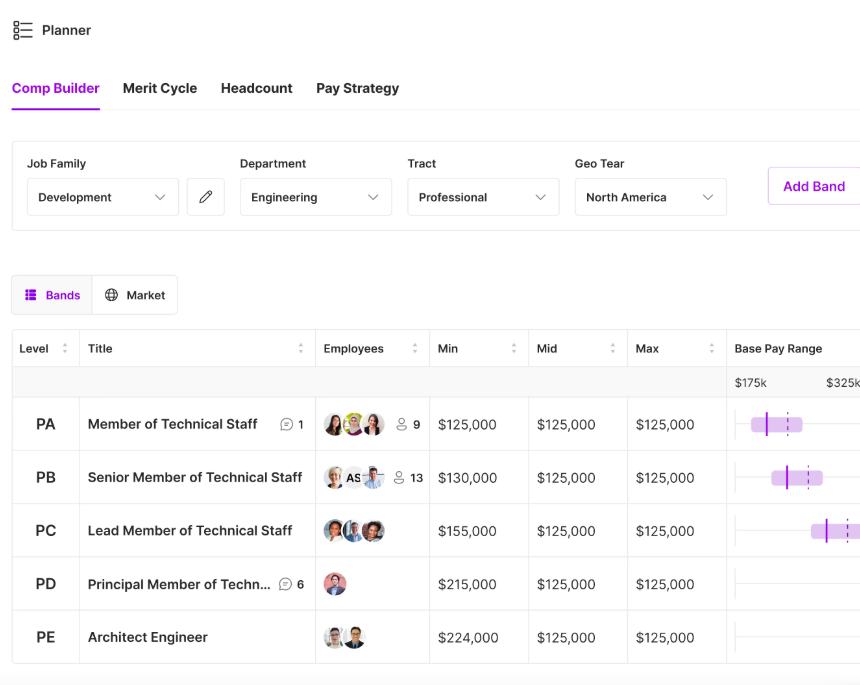
CandorIQ’s Compensation & Payband Builder helps you create and manage pay bands across your organization. This tool allows you to:
- Define pay bands based on job roles, locations, and departments.
- Apply location-based salary adjustments using market data to ensure your pay bands stay competitive.
- Visualize pay distribution across your teams, helping you track pay equity and ensure consistency in your compensation strategy.
- Maintain version control for historical tracking, allowing you to review past pay band changes and ensure compliance.
With this tool, you can easily adjust and monitor your pay bands in real-time, ensuring alignment with your organizational goals.
2. Workforce Management

The Workforce Management tool provides a comprehensive view of your organization’s pay bands in relation to headcount. It allows you to:
- Track compensation alongside headcount to ensure that pay bands align with your workforce planning needs.
- Create custom dashboards to monitor pay band progressions and ensure that compensation remains on track with budget and growth targets.
This tool helps you track both headcount and compensation, ensuring that your pay bands are aligned with your overall workforce strategy.
Conclusion
Managing pay bands and ensuring fair compensation across a growing workforce is a common challenge for HR and Finance teams. With so many factors to consider, it can be difficult to keep pay structures competitive and aligned with your company’s goals.
CandorIQ offers a comprehensive solution designed to streamline compensation management, enabling you to create, manage, and adjust pay bands effectively. Trusted by over 300 leaders, CandorIQ offers the tools you need to ensure pay equity, improve decision-making, and align compensation with both market trends and company goals.
Frequently Asked Questions (FAQs)
Q1. What are the disadvantages of using pay bands?
A1. One disadvantage of pay bands is the potential for salary compression, where employees with similar roles earn the same pay despite differences in experience or performance. Additionally, outdated pay bands may not reflect current market conditions, making it harder to remain competitive.
Q2. Should you share salary band information with your employees?
A2. Sharing pay band information can foster transparency and trust. When employees understand career band levels and salary growth potential, it can motivate them and improve retention. However, be clear about how pay bands work to prevent confusion.
Q3. How do you deal with overlapping salary bands?
A3. Overlapping salary bands can be managed by clearly defining job band expectations. Ensure performance, experience, and responsibilities are used to differentiate pay within overlapping ranges and help guide career advancement within pay bands.
Q4. What is the difference between pay bands and pay scales?
A4. Pay bands offer broader salary ranges, providing more flexibility for career growth, while pay scales are more rigid, with fixed salary limits for specific roles. Pay bands also accommodate job band progression based on performance and responsibilities.
Q5. How often should pay bands be reviewed?
A5. Pay bands should be reviewed regularly, ideally on an annual or biennial basis. Regular reviews ensure that pay bands stay competitive, aligned with market trends, and reflect any changes in job band responsibilities or company goals.


